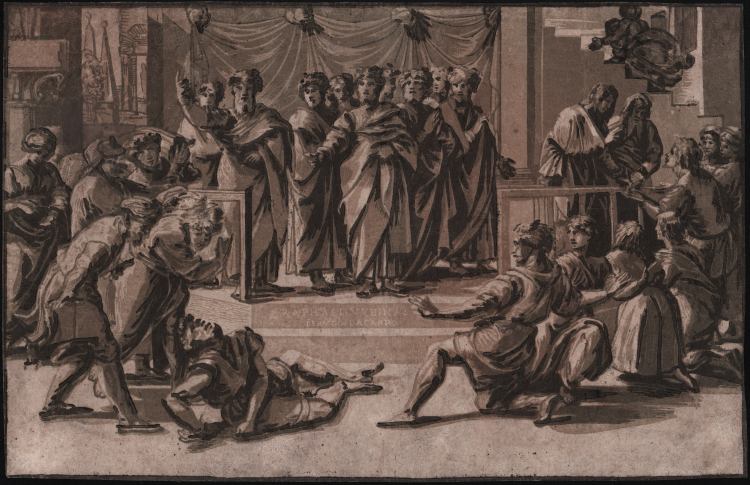




| Reference: | S45339 |
| Author | Ugo da CARPI |
| Year: | 1518 |
| Measures: | 375 x 245 mm |



| Reference: | S45339 |
| Author | Ugo da CARPI |
| Year: | 1518 |
| Measures: | 375 x 245 mm |
The death of Ananias who falls in the center, surrounded by the apostles, after Raphael.
Chiaroscuro woodcut with three blocks in olive, brown and black, 1518. A fine, early, example of the second state of three with inscription on step 'RAPHAEL VRBINAS / PER VGO DA CARPO'.
This print is based on the engraving by Agostino Veneziano (B.XIV.47.42). It was made by Ugo da Carpi in 1518 and the rare earliest impressions carry in the lower margin the text of a Papal privilege. This impression lacks that text but is from the subsequent edition printed by Ugo in which the text has been included within the image.
“Ananias's death is recounted in the Acts of the Apostles (5-11). In the foreground of Ugo's chiaroscuro woodcut, Ananias has been struck down for dishonestly holding back some profits from the sale of his land, which were to be shared among Christ's followers. The gathered witnesses respond in various attitudes of alarm and fear. From the left, figures carry in their contributions for the apostles standing at the center. on a raised platform, while on the right two apostles distribute money. Agostino Veneziano's engraving, which served as Ugo's model, was adapted from one of Raphael's tapestry designs from the lives of the apostles Peter and Paul for the Sistine Chapel (B.XIV.47.42). Although Agostino's Death of Ananias is not dated, his Blinding of Elymas, also after a Raphael tapestry design, is inscribed with the year 1516 - that is, shortly after the preparatory drawings were executed but before the tapestries themselves had been woven in Flanders.
The outlines of the figures and the architectural details in the woodcut and engraving closely coincide, confirming a direct relationship between the two (rather than to an unidentified common source drawing). As with Hercules and Antaeus, David and Goliath, and Massacre of the Innocents, the engraving must have been the model for the chiaroscuro, and not the reverse. The chiaroscuro crops the image on all four sides, presumably because Ugo's available blocks were smaller than the engraving. Moreover, Ugo generalizes the finer details, obfuscating expressions and collapsing spatial relationships that are more clearly articulated in the intaglio. The clarity of the narrative stream, essential to Raphael's design and preserved in the engraving, is thus obscured in Ugo's chiaroscuro woodcut.
Ugo obtained papal and Venetian privileges to protect Death of Ananias and Aeneas and Anchises, both published in 1518. In the first state of Death of Ananias an inscription similar to the one in Aeneas and Anchises declaring Ugo's privileges is printed below the image. These first state impressions are extremely scarce. In the more commonly found second state, "RAPHAEL. VRBINAS/ PER VGO DACARPO" is inscribed on the front of the upper platform step. Small compositional details in the line block design were also modified between these two states. Notably, there are no second state impressions of Death of Ananias with the privilege that was printed below the image in the first state” (cf. N. Takahatake & L. Stiber Morenus, The chiaroscuro woodcut in Renaissance Italy pp. 86-88).
Magnificent proof, rich in tone, printed on contemporary laid paper without watermark, old restorations to upper corners and upper left area, restored tears visible on verso, otherwise in good condition.
Bibliografia
Bartsch A., Le peintre graveur, Vienna, 1803-1821, v. XII, p. 46, n. 27; Matile M., Italienische Holzschnitte der Renaissance und des Barock, Basel, 2003, p. 132; Ugo da Carpi. L'opera incisa. Xilografie e chiaroscuri da Tiziano, Raffaello e Parmigianino, Carpi, 2009, p. 128, n. 19; Gnann A., In Farbe! Clair-obscur-Holzschnitte der Renaissance - Meisterwerke aus der Sammlung Georg Baselitz und der Albertina in Wien, Monaco, 2013, p. 105, nn. 36–37; Stiber Morenus L., The chiaroscuro woodcut printmaking of Ugo da Carpi, Antonio da Trento and Niccolò Vicentino: technique in relation to artistic style, Printing colour 1400 - 1700, Leiden, 2015, 123-139, pp. 124-130; Takahatake N., The Chiaroscuro Woodcut in Renaissance Italy, Los Angeles, 2018, pp. 86-88; Atlante delle xilografie italiane del Rinascimento (ALU.0942.2).
Ugo da CARPI (Carpi 1480 circa – Bologna 1532)
|
Vasari, the sixteenth-century biographer of Italian artists, claimed that Ugo (about 1450-1525) invented the chiaroscuro (light and shade) woodcut. His claim to the invention of this process has long been contested. Hans Burgkmair and Lucas Cranach were known to have made chiaroscuro prints in the north before 1510, whereas there is no definite evidence of Ugo’s work in this technique until 1516, when he appealed to the Venetian senate for protection from his imitators. Carpi was active in Venice and Rome. Many of his chiaroscuro prints are after drawings by Raphael and Parmigianino. None of his paintings survives.
|
Ugo da CARPI (Carpi 1480 circa – Bologna 1532)
|
Vasari, the sixteenth-century biographer of Italian artists, claimed that Ugo (about 1450-1525) invented the chiaroscuro (light and shade) woodcut. His claim to the invention of this process has long been contested. Hans Burgkmair and Lucas Cranach were known to have made chiaroscuro prints in the north before 1510, whereas there is no definite evidence of Ugo’s work in this technique until 1516, when he appealed to the Venetian senate for protection from his imitators. Carpi was active in Venice and Rome. Many of his chiaroscuro prints are after drawings by Raphael and Parmigianino. None of his paintings survives.
|